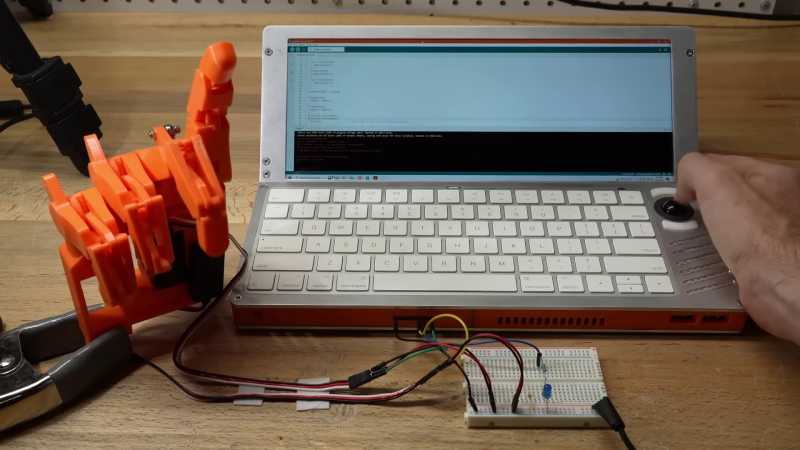The beauty of a modular ecosystem lies in how it allows individuals to repurpose components in unconventional ways. This is precisely what [Ben Makes Everything] has achieved by using a Framework laptop’s motherboard and battery to create a slab-style cyberdeck. (Video, embedded below.)
The Framework motherboard presents an excellent choice for custom portable computer projects due to its relatively compact size and built-in modular I/O port options, all based on USB-C. Framework even released additional documentation to support this use-case. It’s significantly more powerful than the standard Raspberry PI, which is typically employed in similar projects. Ben chose a 2400 x 900 IPS display that can draw power and video through a single USB-C cable. For user input, he opted for an Apple keyboard and an optical trackball with a PS2 interface. He utilized a Arduino Pro Micro as a PS2-to-USB adaptor, using the remaining pins on the Arduino as a versatile interface for electronic projects.
The enclosure is crafted from machined aluminum plates with 3D printed spacers to secure all components. The screen can be tilted up to 45 degrees for more ergonomic desktop use. The Framework motherboard is equipped with four USB-C ports for peripheral devices; [Ben] allocated one for the display and another for a USB hub which connects the keyboard, Arduino, and external USB and HDMI connectors. The remaining USB-C ports are still available for original Framework expansion cards.
The completed project not only looks fantastic but may also be highly functional. It would have been a great entry in our recent Cyberdeck Challenge.















That one is gorgeous!
Crying of joy here. Finally a somewhat small ultra portable with a decent keyboard.
All the really small devices out there cut off a part of the keyboard which means you cannot type using all 10 fingers. I assume this is due to the 16:9 ratio of displays used. You cannot have a border on your screen for design reasons so the obvious solution to this problem is to violate the keyboard. The last device that got this right was the Sony P11.
Just pick an ultra wide screen and match it to the keyboard. as demonstrated here. I love it.
It’s a true beauty!!!!
The one area I disliked was that it doesn’t fold.
Depends on how hard you try…
agree. gorgeous precise design and fabulously executed and looks like a perfect clam-shell form factor but only when I watched the video I realised it had a large non-folding piece below. I guess it would be possible to make the whole thing halve in the middle rather than just the top section – if I followed correctly there was no component that straddled the upper and lower half so battery etc. behind the screen would have allowed the whole thing to fold I think. Could still use it as a flat Tandy style device but could also fold like a Psion 5MX on steroids :-). Nice piece of work regardless.
I wonder how you’d get the trackball to not break the display in the attempt of making it foldable. Making a mechanism to retract the trackball when the shell is closed seems a bit overkill.
It can be as simple as adding a border around the display half as to raise it from the keyboard. For sure it would add a bit of thickness to it, but seeing the deck already being thick, it’s a better compromise than making a complicated tucking mechanism for the trackball.
Very interesting, I hope to see this thing become a product soon.
Also, not far from what the Pocket Popcorn Computer promised, but sadly never delivered. https://pocket.popcorncomputer.com/
Check out the Cambridge Z88 … the original Cyberdeck?? https://youtu.be/PqivyqPW5pM?si=RrnnFONPmZD5Ju8d
I can see the appeal of using something “more powerful” than a Raspberry Pi.
I, however, would take something LESS powerful, provided it can still drive the LCD.
I’m looking for a poweful dumb terminal, with KVM connections, rather than a full blown PC.